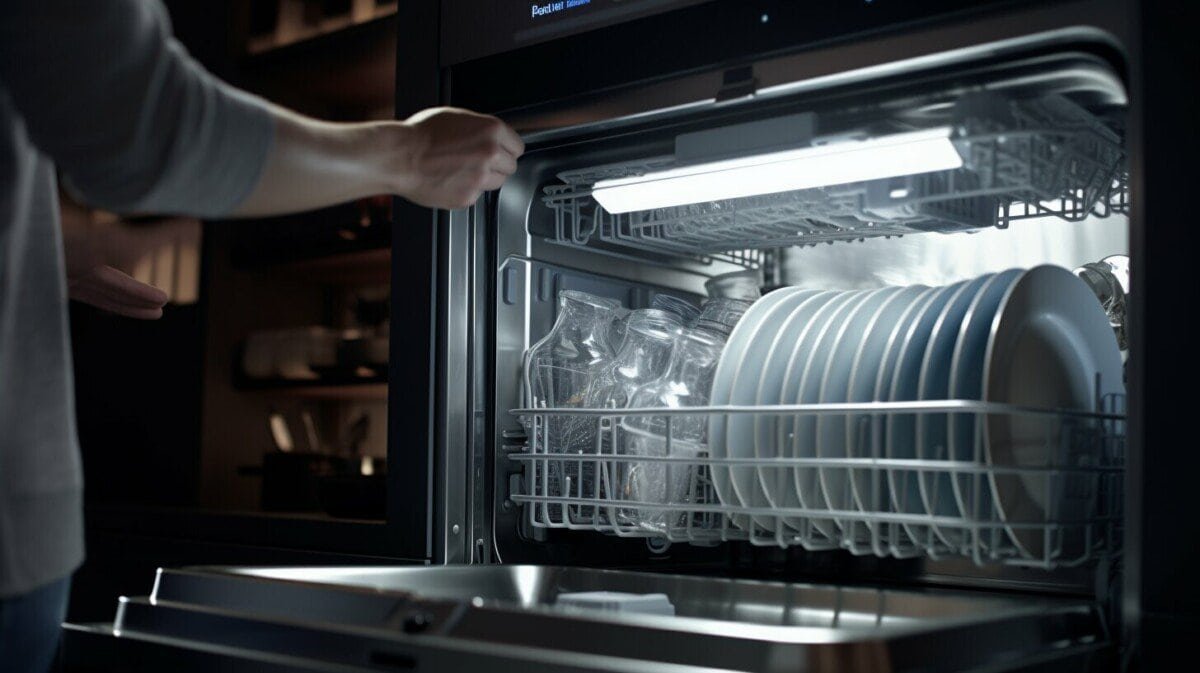Whirlpool dishwashers are known for their efficiency and convenience, but like any appliance, they may experience some issues over time. Thankfully, troubleshooting can help you identify and fix these problems without the need for professional assistance.
This article will cover the most common problems with Whirlpool dishwashers and provide practical solutions for each issue. From dishwasher not starting to leaks and error codes, we’ve got you covered.
Common Dishwasher Problems and Their Causes
Dishwashers are a great convenience, but they can also be a source of frustration when they don’t work properly. Below are some of the most common issues with Whirlpool dishwashers and their underlying causes.
| Problem | Cause |
|---|---|
| Dishwasher not starting | Power supply issues, faulty wiring, malfunctioning control panel |
| Dishwasher not cleaning dishes | Clogged spray arms, malfunctioning detergent dispenser, blocked filter |
| Dishwasher not draining | Clogged drain hose, malfunctioning drain pump, blocked garbage disposal |
| Dishwasher not drying | Malfunctioning heating element, incorrect drying cycle settings |
| Dishwasher leaks | Damaged door gasket, malfunctioning inlet valve, loose or damaged hoses |
| Dishwasher error codes | Malfunctioning control panel, faulty electronic control board |
Being aware of these common problems and their causes can help you troubleshoot your Whirlpool dishwasher efficiently and effectively. In the following sections, we’ll go over each of these issues in more detail, providing troubleshooting tips to help you get your dishwasher working like new again.
Dishwasher Not Starting: Troubleshooting Tips
If your Whirlpool dishwasher won’t start, it can be frustrating and disrupt your daily routine. Before you call a repair technician, it’s worth trying some simple troubleshooting tips to see if you can fix the problem yourself.
Here are some tips to help get your dishwasher up and running:
- Check the power supply: Make sure your dishwasher is plugged in and the outlet is working properly by testing it with another appliance.
- Check the circuit breaker: If your dishwasher won’t start and there is no power, check the circuit breaker to make sure it hasn’t tripped. If it has, reset it and see if that fixes the issue.
- Check the dishwasher door: Make sure the dishwasher door is latched properly. If the door is not fully closed, the dishwasher will not start.
- Check the control panel: If the control panel is not functioning properly, the dishwasher may not start. Try pressing different buttons to see if they respond or if any error codes appear on the display.
- Check for wiring problems: If none of the above solutions work, there may be an issue with the wiring in your dishwasher. In this case, it’s best to call a professional to diagnose and fix the problem.
By following these troubleshooting tips, you can save yourself time and money on expensive repairs. However, always prioritize safety and don’t attempt any repairs that you’re not comfortable with. If in doubt, call a professional.
Dishwasher Not Cleaning Dishes: Troubleshooting Tips
If your Whirlpool dishwasher is not cleaning dishes properly, there are some troubleshooting tips you can try before calling in a professional. Here are some common causes and solutions:
| Issue | Cause | Solution |
|---|---|---|
| Dishes are not getting clean | Spray arms are clogged or damaged | Remove and clean the spray arms, or replace if necessary |
| Dishes have spots or film | Water is too hard or the detergent dispenser is not working properly | Check the water hardness and adjust the detergent amount accordingly. Also, check the dispenser for damage and replace if necessary. |
| Dishes are not loaded properly | Dishes are blocking the spray arms or impeding water flow | Ensure that all dishes are evenly spaced and not blocking the spray arms. Do not overload the dishwasher. |
In addition to these solutions, you can also try cleaning the dishwasher filter to remove any debris that may be affecting the cleaning performance. Refer to your Whirlpool dishwasher manual for instructions on how to remove and clean the filter.
Remember to always unplug your dishwasher and turn off the water supply before attempting any troubleshooting or maintenance.Dishwasher Not Draining: Troubleshooting Tips
One of the most common problems with Whirlpool dishwashers is when they fail to drain properly. This can lead to standing water in the appliance and cause it to stop working. Here are some troubleshooting tips to fix this issue:
Check the Drain Hose
The first step is to check the drain hose for any obstructions. Make sure it is not kinked or twisted, and that there are no blockages inside. It’s also important to ensure that the drain hose is not too high above the sink or the garbage disposal to allow proper drainage.
Inspect the Waste Line
The next step is to inspect the waste line for any clogs or obstructions. Remove the drain basket and pour some water down the drain to see if it flows freely. If not, you may need to use a plunger or drain snake to remove the blockage.
Reset the Garbage Disposal
If your dishwasher is connected to a garbage disposal, make sure it is not clogged or jammed. You may need to reset the disposal or clear any blockages before the dishwasher can properly drain.
Check the Dishwasher Pump
If all else fails, it could be an issue with the dishwasher pump. Remove the dishwasher’s lower spray arm and then check for any debris or objects that could be blocking the pump. You may also need to check the dishwasher’s impeller or motor for any damage or wear.
By following these troubleshooting tips, you can fix a dishwasher that is not draining properly and get your Whirlpool dishwasher working again.
Dishwasher Not Drying: Troubleshooting Tips
If your Whirlpool dishwasher is not drying dishes properly, there are a few troubleshooting tips you can try:
- Check the heating element: The heating element in your dishwasher is responsible for drying your dishes. If it’s not functioning properly, your dishes will come out wet. Use a multimeter to test the element for continuity. If it’s faulty, replace it.
- Ensure proper loading: If your dishwasher is overloaded or dishes are stacked too close together, the hot air cannot circulate properly to dry the dishes. Make sure you’re loading your dishwasher according to the manufacturer’s recommendations.
- Check the drying cycle: If your dishwasher has a drying cycle, make sure it’s turned on. Some models may also have a fan to aid in drying. Ensure the fan is also turned on.
- Use rinse aid: Rinse aid helps water run off dishes more easily, which can aid in the drying process. Make sure you’re using rinse aid and that the dispenser is not empty.
By following these troubleshooting tips, you should be able to get your Whirlpool dishwasher drying dishes properly again. However, if the problem persists, it may be best to call a professional for assistance.
Dishwasher Leaks: Troubleshooting Tips
A leaking dishwasher can be a frustrating problem, but with some quick troubleshooting, you can often identify and fix the issue. Here are some tips for addressing Whirlpool dishwasher leaks:
| Problem | Possible Cause | Solution |
|---|---|---|
| Leak from the Door | Worn or damaged door gasket | Inspect the door gasket for cracks, tears, or wear. Replace if necessary. |
| Leak from the Bottom | Worn or damaged dishwasher inlet valve | Inspect the inlet valve for cracks, leaks or damage. Replace if necessary. |
If the causes above are not what’s causing the leak, then check the dishwasher’s hoses to see if they are properly connected, the loops are high enough, and the hoses themselves are not leaking.
Another possible cause of leaks is that the dishwasher is overloaded. When the dishwasher is overloaded, it can cause the door and seals to warp and not close tightly. Ensure that the dishes are positioned accordingly and that the dishwasher is not overloaded.
As with any dishwasher repair, ensure that the power supply is disconnected before attempting to troubleshoot the problem. Keep in mind that if you’re not comfortable with a DIY fix, it may be best to call a professional to avoid causing further damage.
Dishwasher Error Codes: Troubleshooting Tips
If your Whirlpool dishwasher is displaying an error code, don’t panic. Error codes are designed to help identify the problem so that it can be fixed quickly and efficiently. Here are some common Whirlpool dishwasher error codes and the steps you can take to troubleshoot them:
| Error Code | Description | Troubleshooting Tips |
|---|---|---|
| 1-1 | No Water | Check the water supply and make sure the valve is turned on. Inspect the water inlet valve and the float switch for any damage or wear. |
| 2-1 | Not Draining | Inspect the drain hose and waste line for any obstructions. Check the drain pump for damage. Clear any clogs in the dishwasher’s drain system. |
| 3-1 | Heater Failure | Check the dishwasher’s heating element for any damage or wear. Inspect the electronic control board for any signs of damage or wear. |
| 4-1 | Overfill | Inspect the float switch for any debris or damage. Ensure that the dishwasher is level and that the water inlet valve is functioning properly. |
If you encounter an error code that is not listed here, refer to your Whirlpool dishwasher’s user manual for a complete list of error codes and possible solutions.
When troubleshooting error codes, it’s important to disconnect the dishwasher from its power source and to follow all safety guidelines. If you’re not comfortable troubleshooting the problem on your own, it’s best to call a professional technician.
Whirlpool Dishwasher Maintenance: Keeping Your Dishwasher Running Smoothly
Maintaining your Whirlpool dishwasher is essential to keep it running smoothly and avoid costly repairs. Here are some tips to help extend the life of your appliance:
Clean Your Dishwasher Regularly
Over time, your dishwasher can accumulate food particles, grease, and soap scum that can affect its performance. To keep it clean, remove any debris from the dishwasher’s interior and spray arms, and wipe down the door and gasket with a soft sponge or cloth. You can also use a dishwasher cleaner to remove buildup and odors. Be sure to follow the manufacturer’s instructions when using any cleaning product.
Clean and Replace the Filters
Whirlpool dishwashers have several filters that can become clogged with food particles and debris. Cleaning or replacing them regularly can help prevent blockages and ensure that your dishwasher runs smoothly. Consult your owner’s manual for instructions on how to clean or replace the filters in your dishwasher.
Check the Spray Arms
The spray arms in your dishwasher can become clogged with food particles or mineral buildup, which can affect their ability to clean your dishes. Inspect the spray arms regularly and clean them with a toothpick or pipe cleaner if necessary. Also, make sure that the spray arms can rotate freely.
Use the Correct Detergent and Rinse Aid
Using the right detergent and rinse aid can help your dishwasher function properly and prevent damage to your dishes. Use a high-quality detergent specifically designed for dishwashers, and add rinse aid according to the manufacturer’s instructions. Avoid using too much detergent or rinse aid, as this can leave residue on your dishes and cause problems with your dishwasher.
Run Hot Water Before Starting the Dishwasher
Running hot water in your sink for a few seconds before starting your dishwasher can help ensure that your dishwasher is running with hot water from the start. This can help your dishwasher function properly and prevent problems with cleaning and drying.
Avoid Overloading Your Dishwasher
Overloading your dishwasher can cause problems with cleaning and drying and can even damage your appliance over time. Follow the manufacturer’s recommendations for loading your dishwasher and avoid overcrowding it. If possible, spread out your dishes to allow for sufficient water flow and proper cleaning.
By following these maintenance tips, you can keep your Whirlpool dishwasher running smoothly and avoid common problems. If you encounter any issues or have concerns about your dishwasher’s performance, consult your owner’s manual or contact a professional for assistance.
Additional Dishwasher Troubleshooting Tips
If you’re still experiencing issues with your Whirlpool dishwasher, there are a few additional troubleshooting tips to keep in mind. These tips can help you identify and resolve any issues you may be having:
- Check the water temperature: If your dishwasher isn’t cleaning dishes properly, ensure that the water temperature is set to at least 120 degrees Fahrenheit. If the water isn’t hot enough, dishes won’t be cleaned effectively.
- Inspect the dishwasher spray arm: If your dishwasher isn’t cleaning dishes properly, check that the spray arm isn’t clogged with debris. You can clean it by removing it from the dishwasher and running it under hot water.
- Run the garbage disposal: If your dishwasher isn’t draining properly, ensure that the garbage disposal is running and clear of any debris. A clogged or blocked garbage disposal can cause drainage issues.
- Clean the dishwasher filter: If your dishwasher isn’t draining properly, clean the dishwasher filter located at the bottom of the appliance. A dirty filter can cause drainage issues or even prevent the dishwasher from starting.
- Use the appropriate amount of detergent: Using too much or too little detergent can cause issues with cleaning and draining. Check the detergent packaging for specific instructions on the amount to use.
- Call a professional: If you’ve exhausted all of the troubleshooting tips and your dishwasher still isn’t working properly, it may be time to call a professional. A certified technician can diagnose and repair any issues with your Whirlpool dishwasher.
By following these additional troubleshooting tips, you can help ensure that your Whirlpool dishwasher is working properly and effectively cleaning your dishes.
How Can Snap Ring Pliers Help in Fixing Whirlpool Dishwasher Issues?
Snap ring pliers set can play a crucial role in resolving Whirlpool dishwasher problems. By allowing easy removal and installation of snap rings, these specialized tools simplify the repair process. Whether it’s fixing a leaky hose or replacing a faulty pump, snap ring pliers ensure a secure and efficient repair, saving both time and effort.
Frequently Asked Questions (FAQs)
Here are some frequently asked questions about Whirlpool dishwasher troubleshooting:
Q: My dishwasher is not cleaning dishes, what can I do?
A: One of the most common reasons for dishes not getting clean in a dishwasher is clogged filters. Try checking and cleaning the filters to see if that improves the cleaning performance.
Q: My dishwasher is not draining, what should I check?
A: A clogged drain hose or waste line can prevent water from draining properly. Check for any blockages and clear them if necessary. If the problem persists, there may be an issue with the dishwasher’s pump or motor.
Q: My dishwasher is leaking, what should I do?
A: Check the door gasket for any signs of damage or wear. If the gasket is damaged, it may need to be replaced. Another possible cause for a leak is a faulty inlet valve, which can also be replaced if necessary.
Q: What are some general tips for maintaining my Whirlpool dishwasher?
A: Always rinse dishes before placing them in the dishwasher and regularly clean the interior of the appliance to prevent buildup. Also, regularly clean the filters and check for any signs of wear or damage to replace them if necessary.
Q: When should I seek professional help with my dishwasher?
A: If you have tried troubleshooting tips and the problem persists or if you are uncertain about the cause of the issue, it may be time to call a professional repair service to properly diagnose and fix the problem.




